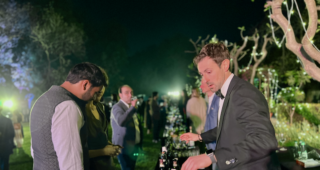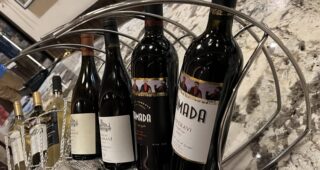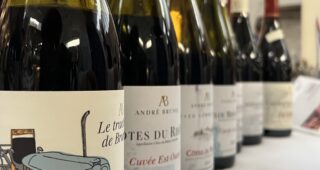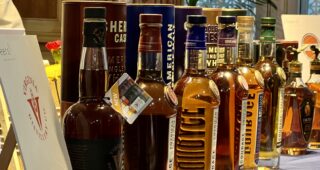Austria is one of the countries privileged to be situated in the ideal wine making latitudinal band of 30-50 degrees. No wonder then, that the country has been known to cultivate vines since as long back as the Celtic era in the 5thcentury B.C. But despite its long oenological history it is only recently that the world has started taking notice of Austrian wines, partly due to the country’s belated but proactive outreach to the world and more significantly, as an outcome of the ever improving wine standards of the country, that rank today as one of the most stringent in existence.
Recently, an Austrian Wine Masterclass was conducted by Wi-Not Beverage Solutions Pvt Ltd– a beverages consultancy company based at New Delhi and headed by sommelier Magandeep Singh who also spearheaded the session at the residence of Dr. Wolfram Moritz, the Austrian Trade Commissioner. In a sit down, deep dive endeavour into the world of Austrian wines, the session looked at the aspects of history, terroir and grape varietals with 12 wineries and more than 50 wines represented.
The masterclass started with a keynote address by H.E. Bernhard Wrabetz, the Ambassador of Austria in India followed by a small presentation on Austrian wine regions and their typicalities. It is noteworthy that almost all the wine regions in Austria are situated towards the eastern side that is more conducive to grape cultivation than the western region better known for its famous skiing slopes. These are summarized as below:

Lower Austria (Niederösterreich)
Situated in the north eastern part of Austria, this region has the river Danube flowing through, that blesses it with the prized Loess – a calcerous clay and silt soil with fossil fragments that provide good drainage and just the right amount of water for favourable vines. The region includes the largest wine area of Weinviertel which is also a DAC (Districtus Austria Controllatus- a classified area similar to French AOC regions).
Sub Regions: Weinviertel, Kamptal, Thermenregion, Kremstal, Wachau, Traisental, Wagram and Carnuntum.
Wines: The region produces mostly white Wines- notably the famous Grüner Veltliner. Sweet and red wines too are produced here. Some of the varietals are- Welschriesling, Riesling, Müller Thurgau, Weissburgunder (Pinot Blanc) , Roter Veltliner and Zweigelt.
Burgenland
Situated south of Lower Austria and bordering Hungary, this region gets the maximum sunlight in Austria and produces several full bodied reds, some great whites and an array of noble sweet wines. The sandy and marshy region beside the lake towards the Hungarian border lends it a microclimate friendly to ‘noble rot’ that enables production of some great sweet wines viz. Strohwein ( straw wine) and Eiswein.
Sub Regions: Neusiedlersee, Leithaberg, Mittelburgenland and Eisenberg.
Wines: Zweigelt, Bläufrankisch, St Laurent, Cabernet Sauvignon, Merlot, Welschriesling Eiswein, Chardonnay, Sauvignon Blanc.
(Lower Austria and Bergenland are collectively called Weinland Osterreich that produces more than 90% of total Austrian Wine production)
Styria (Steiermark)
Towards further south, bordering Slovenia on the south, Styria is a mountainous viticultural area that accounts for a very little portion (around 7%) of Austria’s total Wine production and consumes most of the Wines locally. It is popular for its dry and fragrant style of Wines.
Sub Regions: Sud-Steiermark, Sud-Oststeiermark and Weststeiermark.
Wines: Welschriesling, Sauvignon Blanc, Klevner(Pinot Blanc), Gelber Muskateller(Muscat Blanc À Petits Grains), Morillon (Chardonnay).
Vienna (Wien)
The only capital city of the world that includes a significant wine area within its boundaries, Vienna produces some exclusive Red and White Wines consumed mainly by the locals and the tourists. Grüner Veltliner dominates here not to forget the unique Gemischter Satz – that is a wine produced by fermenting a mix of several grape varieties together.
Sub Regions: Wiener Gemischter Satz (DAC)
Wines: Grüner Veltliner, Pinot Blanc, Riesling, Gemischter Satz.
The Tasting
Taking a departure from the generally accepted ‘Whites first, Reds after’ norm Magan chose to present the wines region-wise to emphasize the terroir aspect. This in effect meant that we tasted whites and reds at random and it worked really well for the intended purpose. To bolster it further, a representative from Sunny Grapes– a marketing agency for several winemakers from Austria presented the unique aspects of each region and the respective winemakers.

Magan presented 14 wines as a headstart and encouraged the participants to try out many others placed at the walk around tasting. It would get mundane to describe all the wines here so here are some of my favourites:

Winery: Alphart
Location: Thermenregion near Vienna (Lower Austria)
Wine: Rotgipfler vom Berg 2013
Impression: A crystal clear light gold wine with fruity, wet leaves and spicy aromas. On the palate it was dry, light bodied with mouth watering acidity and appreciable balance. A good refreshing Wine for a tropical country like India.
Winery: Interrior
Location: Burgenland
Wine: Red Collection 2012
Impression: A light ruby Wine having intense red fruit aromas. Light bodied and juicy on the palate, it had rounded tannins that gently conveyed the underlying structure. Good to have with entrée courses incorporating greens, fruits, poultry and seafood.
Winery: Payr
Location: Carnuntum (Lower Austria)
Wine: Zweigelt Rubin Carnuntum
Impression: A luminescent ruby Wine with aromas of wild berries and oak. On the palate it was dry and medium bodied with medium tannins and reaffirmation of oak. Having flavours of red fruits and spice, this would be the Wine for sterner stuff like pot roasted meat and fried chicken.
Winery: Urbanihof
Location: Wagram (Lower Austria)
Wine: Grüner Veltliner Alte Reben 2013
Impression: Alte Reben meaning ‘prized’, it lived up to its name by being a complex and delightful Wine. Having an antique gold colour with aromas of melon, quince and spice, the Wine was off dry on the palate probably due to its tropical fruit flavours. It had a great finish too!

Winery: Höpler
Location: Burgenland
Wine: Eiswein Pinot Noir 2009
Impression: Eiswein means Wine made from frozen berries where the water freezes out and the grape juice becomes intense and syrupy. This was my first experience of a Pinot Noir Eiswein and it turned out to be a delightful one. An intense honeyed and nutty nose with an explosion of fruit flavours on the tongue had a lingering effect that made it one of the stars of the evening.
The tasting concluded with rounds of filling snacks ensuring that no belly went back grumbling. With lots of wine for company and interesting conversations galore, the evening quite logically refused to budge from its youth.
Showcased wineries and their contact details:
| Winery | Contact Person | Website | ||
|---|---|---|---|---|
| Alphart | Mr. Rudolf Trischler | www.sunnygrapes.at | ||
| Interroir | Mr. Rudolf Trischler | www.sunnygrapes.at | ||
| Payr | Mr. Rudolf Trischler | www.sunnygrapes.at | ||
| Scheiblhofer | Mr. Rudolf Trischler | www.sunnygrapes.at | ||
| Urbanihof | Mr. Rudolf Trischler | www.sunnygrapes.at | ||
| Höpler | Mr. Kerstin Raschl | www.hoepler.at | ||
| Lenz Moser | Ms. Doris Wanek | www.lenzmoser.at | ||
| Muenzenrieder | Mr. Johannes Münzenrieder | www.muenzenrieder.at | ||
| Salomon Undhof | Mr. Bertold Salomon | www.salomonwines.com | ||
| Strehn | Ms. Pia Pneisl | www.strehn.at | ||
| Tement | Mr. Armin Tement | www.tement.at | ||
| Rainer Wess | Mr. Rainer Wess | www.weingut-wess.at | ||
| Zantho | Mr. Thomas Gratzer | www.zantho.com |

P.S. For putting the Austrian title on this post I requested Ms. Shanay Hubmann, the Deputy Trade Commissioner at the Austrian embassy at New Delhi to help- which most kindly she did. Cheers to that!










1 Comment
Great insights…well done Colonel!
Best wishes, Abhimanyu